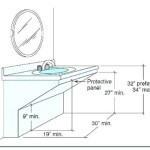Changing A Bathroom Sink Faucet: Essential Aspects
Renovating your bathroom can significantly enhance its aesthetics and functionality, and changing the sink faucet is a quick and easy way to do so. Whether you're a seasoned DIY enthusiast or a complete novice, this guide will provide you with all the essential steps to successfully replace your bathroom sink faucet.
Before embarking on this project, gather the necessary tools and materials, including a new sink faucet, wrench or adjustable pliers, bucket or bowl, plumber's putty, and Teflon tape. Additionally, ensure you have a clean and well-lit workspace for optimal working conditions.
Step 1: Turn Off Water Supply
Begin by turning off the water supply valves located beneath the sink. Most sinks have two valves, one for hot water and one for cold water. Turn the valves clockwise until they are fully closed to prevent any water flow during the faucet replacement.
Step 2: Disconnect Existing Faucet
Using the wrench or adjustable pliers, loosen the nuts that connect the water supply lines to the old faucet. Once loose, carefully detach the lines from the faucet. Remember to keep the bucket or bowl nearby to catch any residual water.
Step 3: Remove Old Faucet
Underneath the sink, locate the large nut that secures the faucet to the sink. Use the wrench or pliers to loosen the nut and gently lift the old faucet out of the sink.
Step 4: Prepare New Faucet
Apply a thin layer of plumber's putty around the base of the new faucet. This will create a watertight seal when the faucet is installed. Additionally, wrap Teflon tape around the threads of the water supply lines for added protection against leaks.
Step 5: Install New Faucet
Place the new faucet into the sink opening and align it with the water supply lines. Tighten the mounting nut underneath the sink to secure the faucet in place. Ensure it is snug but avoid overtightening.
Step 6: Reconnect Water Supply Lines
Connect the water supply lines to the corresponding valves on the new faucet. Tighten the nuts with the wrench or pliers, but be careful not to overtighten and damage the lines.
Step 7: Turn On Water Supply
Return to the valves beneath the sink and slowly open them counterclockwise to restore water flow. Check for any leaks at the connections and tighten as necessary.
Conclusion
Changing a bathroom sink faucet is a relatively simple task that can significantly enhance the style and functionality of your bathroom. By following these step-by-step instructions, you can easily complete this project yourself, saving time and money while gaining a sense of accomplishment.

Diy How To Replace A Bathroom Sink Faucet Remove Install

How To Replace A Bathroom Faucet Home Repair Tutor

Replacing A Bathroom Faucet Fine Homebuilding

Removing And Installing Bathroom Faucets The Lazy Way Makely

How To Remove And Install A Bathroom Faucet

How To Replace A Bathroom Faucet Tinged Blue

How To Replace A Bathroom Faucet Home Repair Tutor

How To Remove And Install A Bathroom Faucet

How To Replace A Bathroom Faucet Removal And Installation

How To Replace Your Bathroom Faucet Plumbcraft Series With Penny
Related Posts







